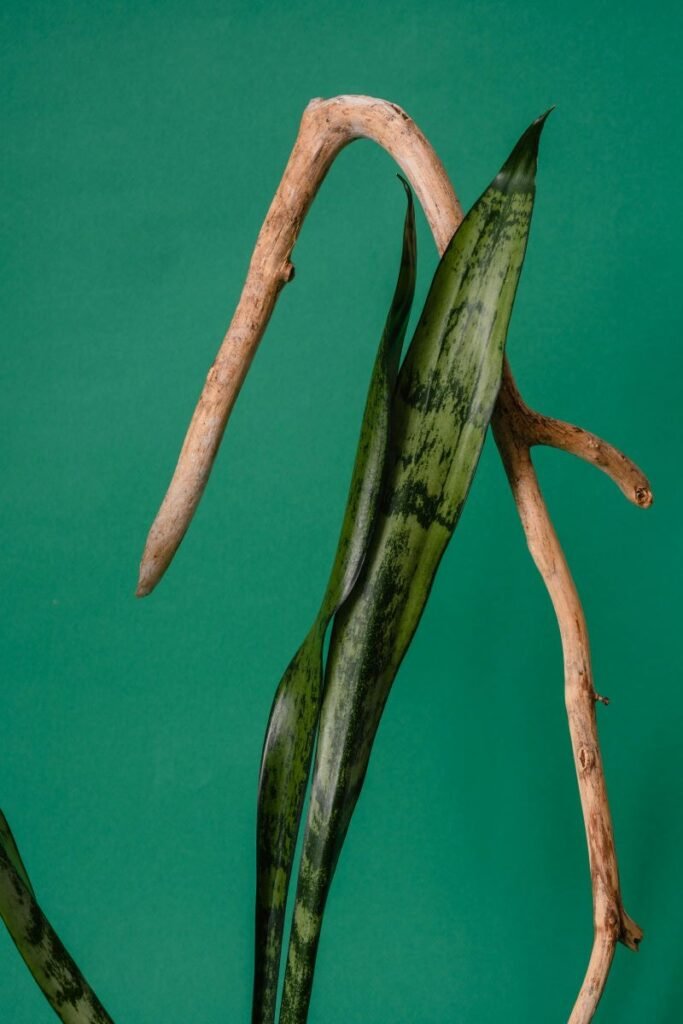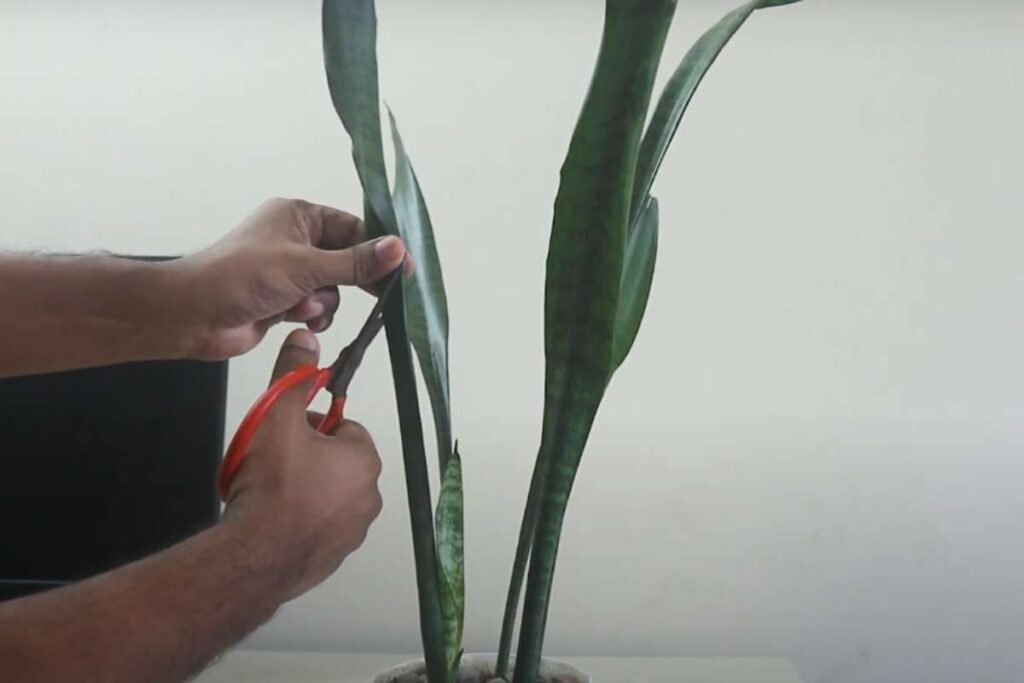Have you noticed your snake plant looking a bit off lately? Those once sturdy, upright leaves now seem thin and reaching for the sky? I’ve been there too. After years of caring for these resilient plants, I’ve learned that when snake plant leaves grow narrow and stretched, they’re trying to tell us something important.
My own snake plant went through this exact problem last year. Those beautiful, thick leaves I loved started growing tall, skinny, and weak. It wasn’t the robust plant I knew. Through research and hands-on experience (including moving mine to a brighter window), I discovered what was happening and how to fix it.
In this post, I’ll share everything I’ve learned about why snake plant leaves stretch out and become narrow. We’ll look at all the causes, solutions, and how to prevent this problem in the future. I’ll also tell you about my own success story of bringing my plant back to its full, healthy glory.
Table of Contents
What Causes Snake Plant Leaves to Become Narrow and Stretched?

Light Deficiency: The Primary Culprit
The main reason snake plants develop narrow, stretched leaves is not getting enough light. This behavior has a name: etiolation. When plants don’t receive sufficient light, they grow taller and thinner in an attempt to reach more light sources.
In my own home, I had my snake plant tucked in a corner of my living room. I thought it looked nice there, but it was too far from any windows. The plant responded by stretching its leaves, making them narrow as it tried to find more light.
Snake plants are often marketed as low-light plants, which is partly true. They can survive in dim conditions, but they won’t thrive there. For optimal growth, they need bright, indirect light. Without it, the plant uses its energy to grow taller instead of filling out with thick, robust leaves.
Signs Your Snake Plant Isn’t Getting Enough Light:
- Leaves grow tall but remain thin
- New growth is paler than older leaves
- The plant leans toward light sources
- Growth slows down overall
- Leaves may feel softer and less firm
When I moved my snake plant next to a north-facing window, the difference was amazing. New leaves grew thicker, and the plant stopped stretching upward so dramatically.
Other Factors That Cause Narrow Leaves
While light is the main issue, other factors can contribute to snake plants developing narrow leaves:
Improper Watering
Snake plants are drought-tolerant succulents that store water in their leaves. When overwatered, the roots can rot, making it hard for the plant to take up nutrients. This stress can lead to thin, weak growth.
On the flip side, extreme underwatering for long periods can also cause leaves to thin out as the plant uses up stored resources.
I found that waiting until the soil is completely dry before watering helps maintain those thick, healthy leaves. Usually, this means watering only once every 2-3 weeks in my home.
Temperature Stress
Snake plants prefer temperatures between 65-85°F (18-29°C). When exposed to temperatures outside this range for extended periods, they may respond with abnormal growth patterns.
Cold drafts are particularly harmful. My plant was once near an air conditioning vent, and those leaves never developed properly. Moving it away from temperature extremes helped tremendously.
Nutrient Deficiencies
Though snake plants aren’t heavy feeders, they do need some nutrients to develop thick, healthy leaves. A lack of nitrogen, potassium, or other key nutrients can result in thin, stretched growth.
I feed my snake plant very lightly with a balanced houseplant fertilizer once in spring and once in summer. More than that isn’t needed.
Pot Size Issues
When snake plants are extremely root-bound, they can’t access enough nutrients and water to support robust leaf growth. However, putting them in pots that are too large can lead to overwatering issues and root rot.
My rule of thumb: repot only when the plant is very root-bound, and use a pot just 1-2 inches larger in diameter than the previous one.
How to Fix Narrow and Stretched Snake Plant Leaves
Move to a Brighter Location
The most effective solution is moving your snake plant to a spot with more light. Snake plants do best in bright, indirect light, though they can handle some direct morning sun.
When I moved my struggling plant to a bright window, the improvement was clear within just a few weeks. New growth came in thicker, and the plant’s color improved.
For those without access to natural light, grow lights are an excellent alternative. I’ve used them in dark corners with good results.
The Right Way to Water
Proper watering makes a big difference in how snake plant leaves develop:
- Wait until the soil is completely dry before watering
- Water thoroughly until it runs out the drainage holes
- Empty the drainage tray
- Let the soil dry out completely before watering again
This cycle helps snake plants develop those strong, thick leaves they’re known for. In winter, I water even less frequently.
Fix Your Soil Mix
Snake plants need well-draining soil to thrive. Regular potting soil often holds too much moisture, which can lead to root problems and poor growth.
I mix my own soil with:
- 2 parts regular potting soil
- 1 part perlite or pumice
- 1 part coarse sand
This mix drains quickly but still holds enough moisture for the plant between waterings.
Provide Proper Nutrition
Feed your snake plant with a balanced houseplant fertilizer at half strength once in spring and once in summer. Over-fertilizing can actually harm the plant and won’t fix stretched leaves.
When I started using this minimal fertilizing schedule, my plant maintained healthy growth without the issues that come with too many nutrients.
Address Temperature and Humidity
Keep your snake plant in a location with stable temperatures between 65-85°F (18-29°C). Avoid placing it near drafty windows, heating vents, or air conditioners.
Snake plants are native to arid regions and prefer lower humidity levels, though they’re adaptable to typical home humidity. If your home is very humid, ensure good air circulation around the plant.
Consider Repotting
If your snake plant is extremely root-bound, it might benefit from repotting:
- Choose a pot 1-2 inches larger in diameter
- Use fresh, well-draining soil
- Carefully remove the plant from its old pot
- Gently loosen the root ball
- Place in the new pot at the same depth as before
- Wait a week before watering
I found that my snake plant’s leaves filled out better after repotting a severely root-bound plant.
Will Existing Stretched Leaves Return to Normal?
This is a question I wondered about too. Unfortunately, once leaves have grown thin and stretched, they won’t revert to a thicker form. Plant cells don’t work that way once they’ve fully developed.
The good news is that with proper care, all new growth will come in healthy and robust. Over time, as your plant produces new leaves, you can remove the stretched ones if they bother you.
I kept some of my plant’s stretched leaves as they weren’t unhealthy, just not as attractive. Eventually, the plant produced enough new, thick leaves that the old ones weren’t noticeable.
Prevention Is Better Than Cure
Preventing narrow, stretched leaves is much easier than fixing them after they’ve developed. Here’s what works for me:
Light Management
Place your snake plant near a window with bright, indirect light. East or west-facing windows usually work well. South-facing windows might be too intense during summer months unless the light is filtered through a sheer curtain.
If natural light is limited, supplement with grow lights. LED grow lights are energy-efficient and don’t generate much heat.
Seasonal Adjustments
Light levels change with the seasons. A spot that works perfectly in summer might be too dark in winter. I move my snake plants closer to windows during fall and winter when days are shorter.
Regular Rotation
Turn your plant a quarter turn every week. This prevents it from leaning toward the light source and ensures all sides receive equal light exposure.
This simple habit has helped my plants grow straight and develop even, thick leaves all around.
Special Considerations for Different Snake Plant Varieties
Different snake plant varieties have naturally different leaf shapes. Some cultivars naturally have thinner leaves than others.
Common Varieties and Their Natural Leaf Shapes:
- Sansevieria trifasciata ‘Laurentii’ – Broad, thick leaves with yellow edges
- Sansevieria trifasciata ‘Black Gold’ – Thick, dark green leaves with yellow margins
- Sansevieria cylindrica – Naturally thin, cylindrical leaves
- Sansevieria trifasciata ‘Futura Superba’ – Naturally shorter with wide leaves
- Sansevieria trifasciata ‘Moonshine’ – Wide, pale silvery-green leaves
I once worried about my Sansevieria cylindrica having thin leaves until I realized that’s just how they grow! Make sure you know what’s normal for your specific variety.
The Recovery Timeline: Be Patient
How long does it take for a snake plant to recover from etiolation? In my experience, you’ll see changes in these timeframes:
- 2-4 weeks: The plant stops active stretching once moved to better light
- 1-2 months: New leaves begin to emerge with better form
- 3-6 months: Several new, healthier leaves develop
- 6-12 months: The plant looks fully recovered with many new, properly formed leaves
Remember that plant growth is slower in fall and winter, so recovery might take longer during these seasons.
Common Questions About Narrow Snake Plant Leaves

Can I cut off stretched leaves?
Yes, you can prune severely stretched leaves if they bother you. Cut them at the base near the soil line using clean, sharp scissors or pruning shears.
I usually wait until the plant has produced several new, healthy leaves before removing old ones. This gives the plant enough foliage to photosynthesize effectively.
Will my snake plant die if the leaves are stretched?
No, stretched leaves are not usually a sign that your plant is dying. They indicate suboptimal growing conditions, primarily insufficient light. Address the underlying cause, and your plant should recover.
My stretched snake plant was far from dying – it was actually trying very hard to survive by reaching for more light!
How much light do snake plants actually need?
Despite their reputation as low-light plants, snake plants do best in bright, indirect light for 6-8 hours daily. They can tolerate lower light conditions but won’t thrive and will develop stretched leaves.
I’ve found that spots about 3-6 feet from a bright window provide ideal light for most snake plants.
Can snake plants get too much light?
Yes, while they need bright light to prevent stretching, direct, intense sunlight (especially afternoon sun) can scorch their leaves. If you notice brown, crispy patches developing, the plant might be getting too much direct sun.
Do grow lights work for snake plants?
Absolutely! I’ve used LED grow lights with great success for snake plants in darker corners of my home. Position the light about 12-24 inches above the plant and keep it on for 8-10 hours daily.
My Personal Success Story
Last year, my favorite snake plant started developing those characteristic narrow, stretched leaves. It was in what I thought was a nice spot in my living room, but clearly the plant disagreed!
After learning about etiolation, I moved it to a spot next to a north-facing window. The difference was remarkable. Within a month, I noticed the plant had stopped its upward stretching. Two months later, new leaves started emerging, and they were noticeably thicker than the previous growth.
I kept the old stretched leaves for a while, but as the plant filled in with healthy new growth, I gradually pruned them away. Six months later, my snake plant looked like a completely different specimen – full, robust, and with those classic thick leaves I love.
The most important lesson I learned is that while snake plants are indeed tough and can survive in low light, they won’t look their best there. They need good light to develop their characteristic thick, upright leaves.
Conclusion: Working With Your Plant, Not Against It
Understanding why your snake plant’s leaves are growing narrow and stretched is the first step to solving the problem. In most cases, your plant is simply telling you it needs more light.
By moving my plant to a brighter location, adjusting my watering routine, and making sure it had the right soil, I was able to completely turn around its health. Now, it’s one of the most impressive plants in my collection, with thick, robust leaves that stand tall.
Remember that plant care is often about responding to what your plants are telling you. Those stretched leaves were my snake plant’s way of saying, “Help! I need more light!” Once I listened and responded, the plant flourished.
Have you noticed your snake plant stretching for the sky? Try moving it to a brighter spot and watch the transformation happen. Your patience will be rewarded with a healthier, more attractive plant.
My name is Shahriar Robin, and my journey with plants began in childhood, igniting a lifelong passion that blossomed alongside my career as a nutritionist and sports trainer. Through SnakePlant.org, I channel this dedication, merging expertise from nutrition and sports training to nurture a platform sharing all-encompassing knowledge about Snake plants. This website mirrors my commitment to cultivating greenery, offering comprehensive insights on growth, maintenance, and nurturing practices for these captivating plants. My mission is rooted in leveraging diverse expertise to enhance plant care practices, believing profoundly in the therapeutic impact of nature. Join me on SnakePlant.org, where I unite a thriving community of enthusiasts, sharing experiences, insights, and the profound joys of planting.

